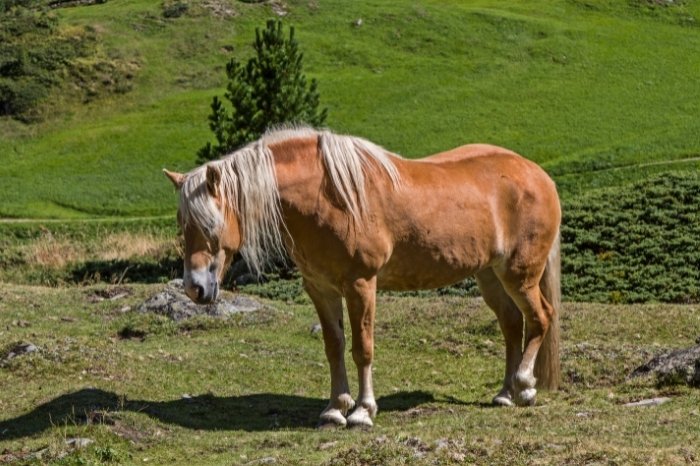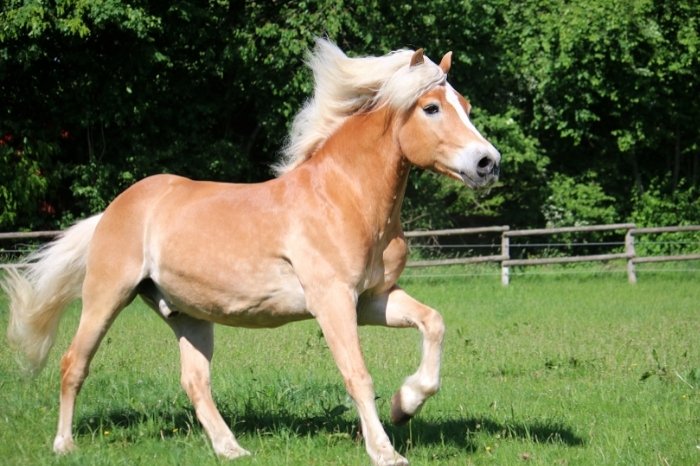Last Updated on March 15, 2022
What is a Haflinger horse, well it is one of an estimated 350 horse breeds in the world and one of the most special, rare equines you will come across? You might be familiar with the name Haflinger, but know little else about this breed. Here we will dive into the origins and characteristics of this wonderful little horse.
Haflinger Horses History
The Haflinger originates in the Austrian mountains, in the Tyrol region. Like many horse breeds, the name comes from the village where the horse developed. In this case, the Haflinger comes from Hafling.
Hafling is now part of Italy, but prior to World War I, it was in Austria. The foundation of the breed starts in 1874. This is when the first official Haflinger stallion, 249 Folie, is born. 249 Folie is the result of a cross between a half Arabian stallion and a Tyrolean mare.
The Tyrolean is a native Austrian horse. The mother of 249 Folie, was specially chosen for her, particularly refined look. Every Haflinger born since 1874 traces its pedigree back to 249 Folie. The official Haflinger stud opened in 1921.

From there, the world discovered the breed and several Haflinger breed societies established themselves around the world. Today, the breed and its societies follow standards set by the World Haflinger Federation. Unlike the early period of many breeds, the Haflinger has no cold-blood horse genetics.
The native Tyrolean, a major influence on the breed, is a small warmblood horse. The part of the Alps where this breed originates never saw cold blood breeds.
The first Haflinger arrived in the United States in 1958. It took another 19 years for the first Haflinger registration in Canada. While some Haflinger breeding takes place around the world, the majority still come from Austria.
Haflinger Horse Size
The Haflinger is a small, sturdy horse. The region where the breed developed consisted of small farms set amongst steep hillsides. Larger horses would not have been able to traverse the paths between these farms, nor could the environment provide the food needed.
In the early 1900s, before the start of World War I, the average height of the Haflinger is just under 15 hands, or 150cm. Today, the Haflinger stands between 13.2 and 15 hands tall. It is easy to mistake the Haflinger for a pony due to its size, but it is a horse.
10″ Pony Horse Saddle Kids Cowboy Cowgirl Pleasure Leather Brown
Use Of The Haflinger
The first Haflingers worked on farms. Not doing heavy work but as a carrier of supplies between farms and bringing harvests from the steeply set fields. It also did work in the forest.
With the coming of machines, the Haflinger was not necessary on farms. Its fairly light frame and wonderful temperament made it easy to switch the Haflinger to other activities. Today, it is a great mount for riders of all ages and abilities.
You will see the Haflinger in many surprising equestrian activities. They take part in dressage, jumping, combined driving, therapeutic riding, and trekking.
Haflinger Characteristics
One of the most unique characteristics of the Haflinger is its color. All Haflingers are chestnuts. They come in many chestnut shades from deep golden to liver chestnut to light almost palomino color.
Haflingers have white or blonde manes, making them one of the most striking-looking horse breeds. The body of the Haflinger is rectangular with a pretty, refined head. They have strong backs and good hocks that allow them to safely navigate rough terrain.

The gait of the Haflinger is energetic and smooth, making it a comfortable and enjoyable horse to ride. Due to the sometimes harsh environment of their origin, the Haflinger evolved as an easy keeper.
Haflingers are not only versatile but also possess good longevity. Many live well into their 30s and can comfortably continue work into their 20s.
The temperament of the Haflinger is one of the best amongst horse breeds. It is a willing, gentle horse, that stays calm in many situations. This is what makes the breed such a good therapeutic riding horse.
Interesting Haflinger Facts
- The Haflinger is an intelligent breed that enjoys doing work. Behavioral issues can arise if it is confined for too long in a stable without going out to exercise.
- Like most horses, the Haflinger is social and is happiest with other horse companions.
- Breeding standards ensure those with faults are not part of breeding programs. This allows the breed to remain one of the healthiest and soundest types of horses.
- The first horse ever cloned was a Haflinger filly named Prometea.
- The breed almost disappeared during the world wars as many were confiscated to work as pack animals for mountain battles.
- All Haflinger breeding stallions are owned by the Austrian government or approved by them.
- The current Haflinger population is around 250,000.
Haflinger Horse Breed Conclusion
The Haflinger is a small warmblood horse with athletic ability and a fantastic temperament. It needs good training and plenty of exercises. When these basic needs are met, the Haflinger is the perfect family horse.
What breeds are in a Haflinger?
The Haflinger is a rare breed that combines Arabian and other European breeds with native Tyrolean ponies. It has been in existence for over two hundred years. The name is derived from Hafling, a small village in Austria. Haflingers are well known for their speed, endurance, and intelligence.
What is the temperament of a Haflinger?
Haflingers are a breed of horse that is extremely patient, easy to train, and has a very tolerant disposition towards riders. Because of their gentle nature they are suitable for children, and are often used as a therapeutic horses.
The Haflinger is an ideal horse for a variety of activities, including dressage, driving, reining, and eventing. The Haflinger is an extremely versatile horse that can be trained to perform a variety of tasks. They are also very inteligent and usually easy to train.
Haflingers are usually calm and relaxed, but when frightened they can become nervous and skittish.
Are Haflingers prone to laminitis?
Haflingers are generally healthy, but the breed does have certain potential health issues that can be very serious, like chronic laminitis. Laminitis happens for several reasons, but in Haflingers, it typically happens from the intake of too much rich grass or grain.
Laminitis is a relatively common problem in horses, so it’s important to watch out for signs of laminitis. The most common sign is a change in the way your horse walks. When your horse starts to limp, or his/her walk becomes noticeably uneven, it’s time to pay attention. Laminitis is a serious condition that can cause a horse to go lame and even die. It’s usually caused by changes in the hoof, including cracks and damage from over-use. It can also be caused by problems in the leg itself, like soreness or a twisted tendon.
Are Haflinger horses good for beginners?
Haflinger horses are usually reserved for more experienced riders but if the right precautions are taken, they can be a good breed for beginners. They are intelligent horses that are fun to ride but may test their rider’s patience with their sometimes challenging behavior.
The Haflinger has a good sense of balance and is an excellent horse for dressage. This is an intelligent breed with a strong sense of loyalty and self-confidence. They are very willing workers. They can be a bit nervous when faced with new situations but once they get used to it, they will become a true companions.
Is Haflingers a Palomino?
A popular misconception about Haflingers is that they are all palominos – but they’re not. Their coat color can range from light to dark chestnut with light manes and tails. Most horses have white or flaxen manes and tails. Any deviations from those shades are considered undesirable.
The Haflinger is known for being a hardy, energetic horse with great endurance. They are generally very smart and have excellent working skills. These characteristics have made them a favorite of horse-loving people throughout the world. Haflingers are found in the northern hemisphere, including North America, Europe, Russia and Asia. They were originally bred in the southern part of the Black Forest in Germany and Austria. They were originally bred to work in mountainous regions as pack animals.
Michael Dehaan is a passionate horse owner, horse rider, and lover of all things equine. He has been around horses since he was a child, and has grown to become an expert in the field. He has owned and ridden a variety of horses of different breeds, and has trained many to compete in shows and competitions. He is an experienced horseman, having worked with and competed many horses, including his own. He is an active member of the equestrian community, participating in events and teaching riding lessons.

